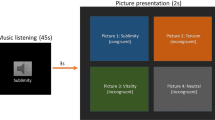Abstract
Very long-term memory for popular music was investigated. Older and younger adults listened to 20-sec excerpts of popular songs drawn from across the 20th century. The subjects gave emotionality and preference ratings and tried to name the title, artist, and year of popularity for each excerpt. They also performed a cued memory test for the lyrics. The older adults’ emotionality ratings were highest for songs from their youth; they remembered more about these songs, as well. However, the stimuli failed to cue many autobiographical memories of specific events. Further analyses revealed that the older adults were less likely than the younger adults to retrieve multiple attributes of a song together (i.e., title and artist) and that there was a significant positive correlation between emotion and memory, especially for the older adults. These results have implications for research on long-term memory, as well as on the relationship between emotion and memory.
Similar content being viewed by others
References
Bahrick, H. P. (1983). The cognitive map of a city—50 years of learning and memory. In G. H. Bower (Ed.),The psychology of learning and motivation: Advances in research and theory (Vol. 17, pp. 125–163). New York: Academic Press.
Bahrick, H. P. (1984a). Memory of people. In J. E. Harris & P. E. Morris (Eds.),Everyday memory actions and absentmindedness (pp. 19–34). New York: Academic Press.
Bahrick, H. P. (1984b). Semantic memory content in permastore: Fifty years of memory for Spanish learned in school.Journal of Experimental Psychology: General,113, 1–29.
Bahrick, H. P., Bahrick, P. O., &Wittlinger, R. P. (1975). Fifty years of memory for names and faces: A cross-sectional approach.Journal of Experimental Psychology: General,104, 54–75.
Bartlett, J. C., &Snelus, P. (1980). Lifespan memory for popular songs.American Journal of Psychology,93, 551–560.
Bower, G. H. (1981). Mood and memory.American Psychologist,2, 129–148.
Burke, A., Heuer, F., &Reisberg, D. (1992). Remembering emotional events.Memory & Cognition,20, 277–290.
Cavanaugh, J. C., &Green, E. E. (1990). I believe, therefore I can: Personal beliefs and memory aging. In E. A. Lovelace (Ed.),Aging and cognition: Mental processes, self-awareness, and interventions (pp. 189–230). Amsterdam: North-Holland.
Christianson, S.-Å. (1992). Emotional stress and eyewitness memory: A critical review.Psychological Bulletin,112, 284–309.
Conway, M. A., &Bekerian, D. A. (1987). Organization in autobiographical memory.Memory & Cognition,15, 119–132.
Conway, M. A., &Rubin, D. C. (1993). The structure of autobiographical memories. In A. F. Collins, S. E. Gathercole, M. A. Conway, & P. E. Morris (Eds.),Theories of memory (pp. 103–137). Hove, U.K.: Erlbaum.
Crovitz, H. F., &Schiffman, H. (1974). Frequency of episodic memories as a function of their age.Bulletin of the Psychonomic Society,4, 517–518.
Elrod, B. C. (1994).Your hit parade & American top ten hits: A weekby-week guide to the nation’s favorite music, 1935–1994. Ann Arbor, MI: Popular Culture.
Galton, F. (1879). Psychometric experiments.Brain,2, 149–162.
Heuer, F., &Reisberg, D. (1992). In S.-Å. Christianson (Ed.),Handbook of emotion and memory: Research and theory (pp. 151–180). Hillsdale, NJ: Erlbaum.
Krumhansl, C. L. (1997). An exploratory study of musical emotions and psychophysiology.Canadian Journal of Experimental Psychology,51, 336–352.
Pansepp, J. (1995). The emotional source of “chills” induced by music.Music Perception,13, 171–207.
Rubin, D. C. (1995).Memory in oral traditions: The cognitive psychology of epic, ballads, and counting-out rhymes. New York: Oxford University Press.
Rubin, D. C., Rahhal, T. A., &Poon, L. W. (1998). Things learned in early adulthood are remembered best.Memory & Cognition,26, 3–19.
Rubin, D. C., &Schulkind, M. D. (1997a). The distribution of autobiographical memories across the lifespan.Memory & Cognition,25, 859–866.
Rubin, D. C., &Schulkind, M. D. (1997b). Distribution of important and word-cued autobiographical memories in 20-, 35-, and 70-yearold adults.Psychology & Aging,12, 524–535.
Rubin, D. C., Schulkind, M. D., &Rahhal, T. A. (1999). A study of gender differences in autobiographical memory: Broken down by age and sex.Journal of Adult Development,6, 61–71.
Rubin, D. C., Wetzler, S. E., &Nebes, R. D. (1986). Autobiographical memory across the lifespan. In D. C. Rubin (Ed.),Autobiographical memory (pp. 202–221). New York: Cambridge University Press.
Wallace, W. T. (1994). Memory for music: Effect of melody on recall of text.Journal of Experimental Psychology: Learning, Memory, & Cognition,20, 1471–1485.
Wallace, W. T., & Schulkind, M. D. (1999).Structural and substantive processing of text. Manuscript in preparation.
West, R. L., &Berry, J. M. (1994). Age declines in memory selfefficacy: General or limited to particular tasks and measures? In J. D. Sinnott (Ed.),Handbook of adult lifespan learning (pp. 426–445). Westport, CT: Greenwood.
Whitburn, J. (1993).Billboard Top 1000 Songs, 1955–1992. Milwaukee, WI: Leonard.
Yalch, R. F. (1991). Memory in a jingle jungle: Music as a mnemonic device in communicating advertising slogans.Journal of Applied Psychology,76, 268–275.
Author information
Authors and Affiliations
Corresponding author
Rights and permissions
About this article
Cite this article
Schulkind, M.D., Hennis, L.K. & Rubin, D.C. Music, emotion, and autobiographical memory: They’re playing your song. Mem Cogn 27, 948–955 (1999). https://doi.org/10.3758/BF03201225
Received:
Accepted:
Published:
Issue Date:
DOI: https://doi.org/10.3758/BF03201225




